
The Mayor Gallery, London
8 September – 15 October 2021
by ANGERIA RIGAMONTI di CUTÒ
As early as the 1940s, Lucio Fontana’s shock gesture of rupturing the canvas transmuted what had been the mere backdrop of the artwork into a portal leading to its surrounding space, both the viewer’s and the infinite space of the cosmos behind the canvas, according to his simultaneously mystic and concrete vision.
In the wake of Fontana’s brilliantly simple breaching of the canvas’s purity, a younger generation of Italians developed other means of assailing the integrity and isolation of the canvas. By the late 50s, artists such as Agostino Bonalumi and Enrico Castellani manipulated their surfaces with sequences of protrusions and recessions, a direction that Turi Simeti would go on to pursue from the 60s until the end of his life this year. The current exhibition at the Mayor Gallery presents works spanning an expansive 40 years of his career.
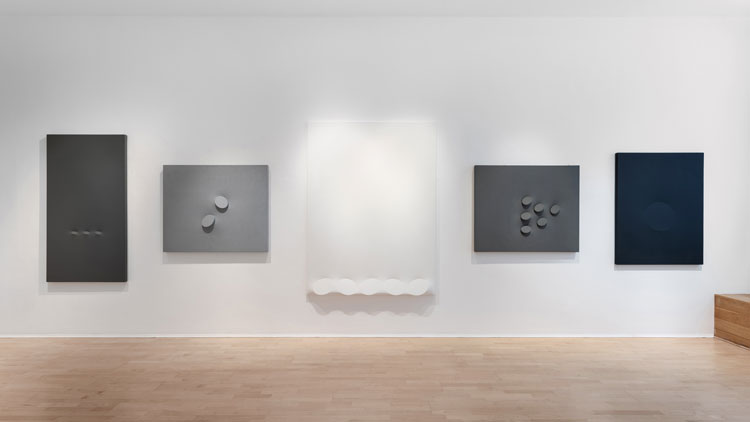
Turi Simeti (1929-2021): A Homage, installation view, The Mayor Gallery, London, 2021.
With no formal training, the Sicilian-born Simeti came to art through a series of fortuitous encounters with some of Italy’s most radical artists. Having abandoned studies in law and veterinary medicine, he found a lucrative day job in Rome selling art encyclopaedias, an activity he claimed to have excelled at. As luck would have it, one of his customers was Alberto Burri, whose studio he began to frequent.
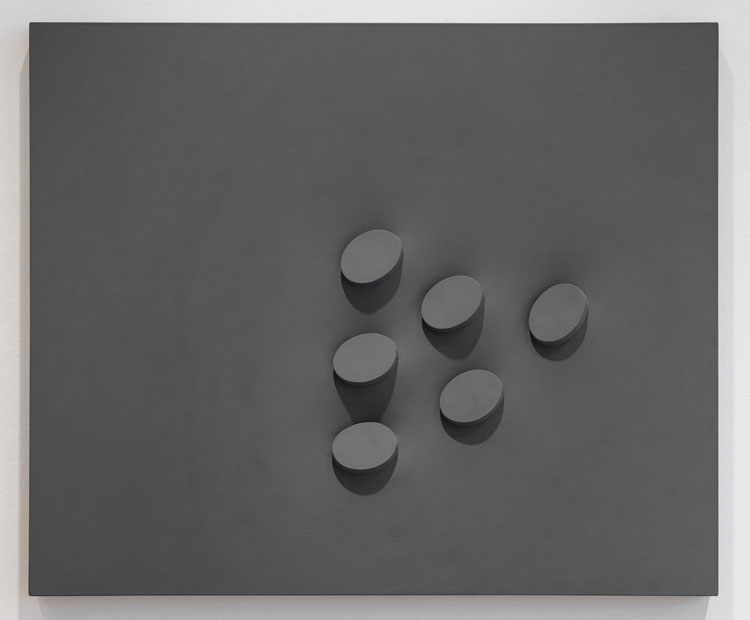
Turi Simeti. Sei ovali in grigio, 1993. Acrylic on shaped canvas, 47 1/4 x 39 3/8 in (120 x 100 cm). Image courtesy The Mayor Gallery.
Perhaps unsurprisingly, Simeti’s early experiments with artmaking were markedly under the influence of Burri. He would burn the edges of sheets of paper and the charred remains of those essays assumed the oval shape that would consume Simeti for the rest of his career, with little deviation beyond some experimentation with rectangles and circles, and a brief op-art stint. At first, he would cut ovals out of cardboard or wood in the manner of an artisan, facing the entire surface of the canvas – one such work being collaged with an impressive 414 ellipses.
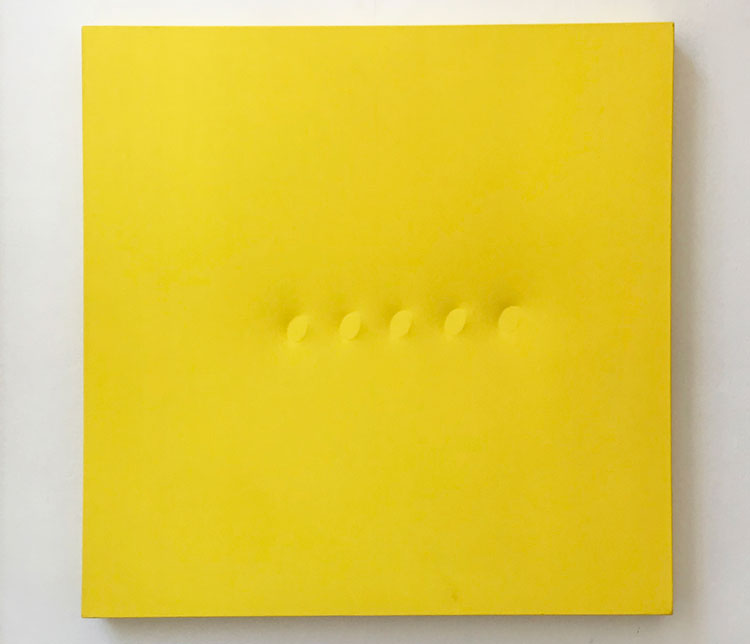
Turi Simeti. Sei ovali gialli, 2018. Acrylic on shaped canvas, 27 1/2 x 27 1/2 in (70 x 70 cm). Image courtesy The Mayor Gallery.
A chance meeting with Nanda Vigo in 1965 led to Simeti being invited to exhibit his work at the fabled exhibition of Zero artists she had organized in Fontana’s Milanese atelier. To show at that exhibition was to be promptly catapulted into Europe’s artistic vanguard, a network that was global avant la lettre, freely crossing borders of nations and other artistic collectives such as arte povera, American minimalism, French nouveau réalisme and the Gutai group in Japan (Piero Manzoni was nicknamed “Zero Mercury” by founder member Otto Piene because of his manic travelling between Europe’s artistic hubs).
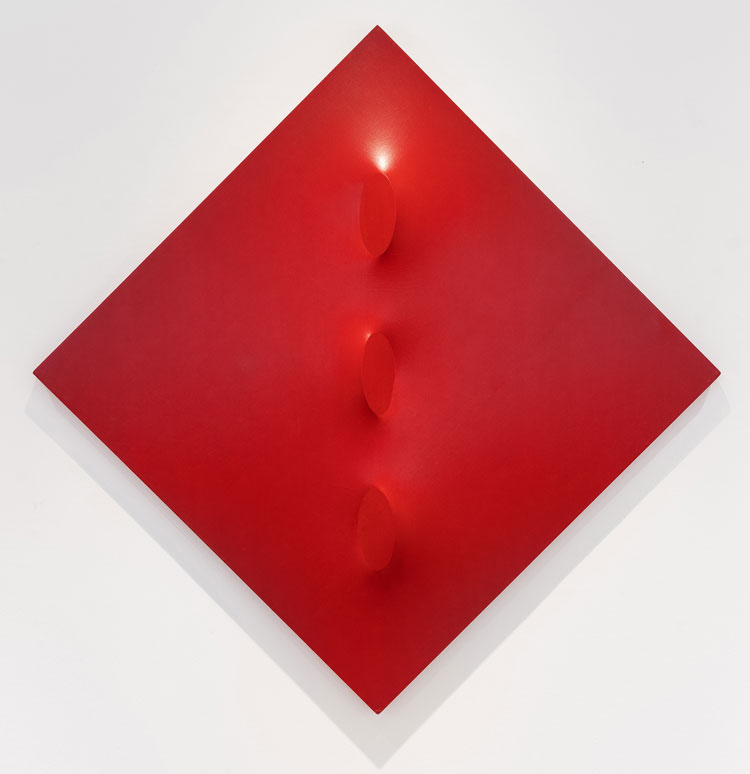
Turi Simeti. Tre ovali in rosso, 1967. Oil on shaped canvas, 47 ¼ x 47 ¼ in (120 x 120 cm). Image courtesy The Mayor Gallery.
The 2014 Guggenheim survey, ZERO: Countdown to Tomorrow, 1950s-60s, assured the group’s prominent role within Eurocentric modernism, with many of its exponents – including Heinz Mack, Piene, Günther Uecker, Yves Klein, Manzoni, Fontana, Dadamaino and Yayoi Kusama – now securely entrenched in the postwar canon.
Simeti’s participation in the Milanese ZERO exhibition also resulted in Fontana, the de facto godfather and generous champion of younger avant-garde artists, acquiring one of his works. Always a loosely constituted network, there were marked differences as well as elective affinities in the ways the artists associated with Zero interfered with the canvas, though the critic Lawrence Alloway’s claim that Zero “was the first artists’ collaboration devoted to topics of light and movement” offers an apt delineation of a common ground of many of these artists.
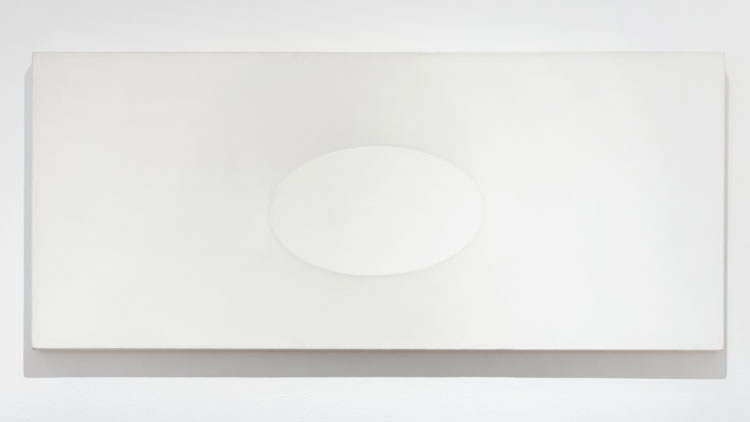
Turi Simeti. Superficie bianca con un ovale, 1988. Acrylic on shaped canvas, 23 5/8 x 55 1/8 in (60 x 140 cm). Image courtesy The Mayor Gallery.
Compared with Castellani and Bonalumi, Simeti reduced his repetition of forms to a less-is-more minimum, through the idée fixe of the oval. Following his earlier experiments with collaged ovals, the crux of his single-minded and lifelong focus became the transformation of the canvas as engineered behind rather than in front of its membrane, with his ovoid structures, some subtle, others more assertive, creating a point of tension, as well as a foil for the play of light, shadow and movement on its surface.
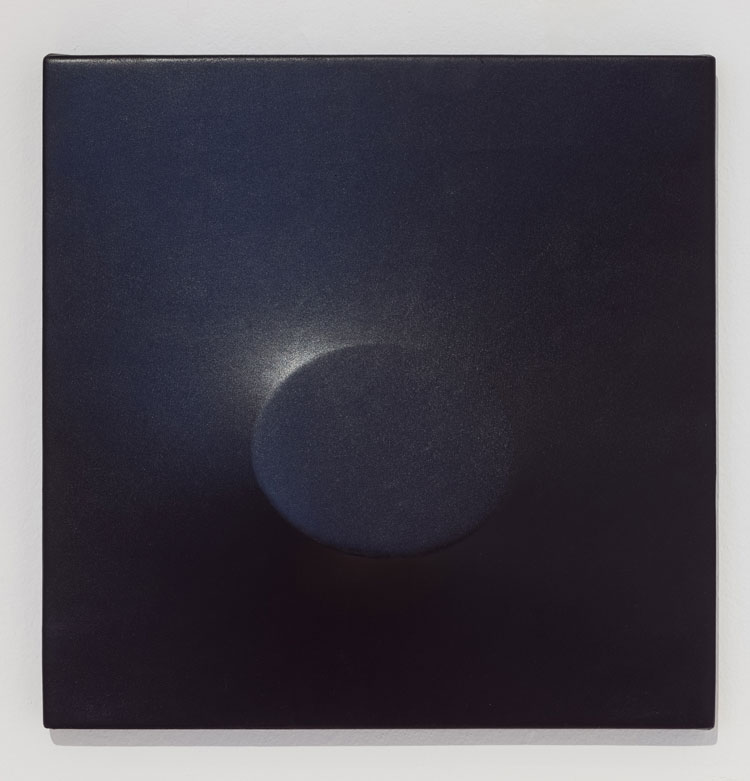
Turi Simeti. Un ovale blu, 2005. Waxed shaped canvas, 15 3/4 x 15 3/4 in (40 x 40 cm). Image courtesy The Mayor Gallery.
The other crucial element in that interplay was Simeti’s sustained use of the monochrome, with most of his canvases painted within the confines of a restricted nucleus of five colours: white, black, saturated blues, reds and yellows, a palette also adopted by some of his contemporaries (and while Fontana is rightly seen as a father figure, influences flowed both ways, with his shift to a similar palette in the later cut paintingsascribed to the influence of younger artists associated with Zero).
Within those strictures of form, structure and colour, a close viewing of Simeti’s works reveals a variety of paint finishes, from a relatively matt acrylic that doesn’t conceal the canvas’s texture, to the high lustre of a wax medium – Simeti was known to apply multiple layers of paint until he reached the desired effect.
Relatively neglected in comparison with his Italian confreres, Simeti’s reliefs seem subtler than Bonalumi and Castellani’s busier, all-over extroflexions, ultimately closer to the more penetrating distillation of Fontana’s lacerated surfaces.
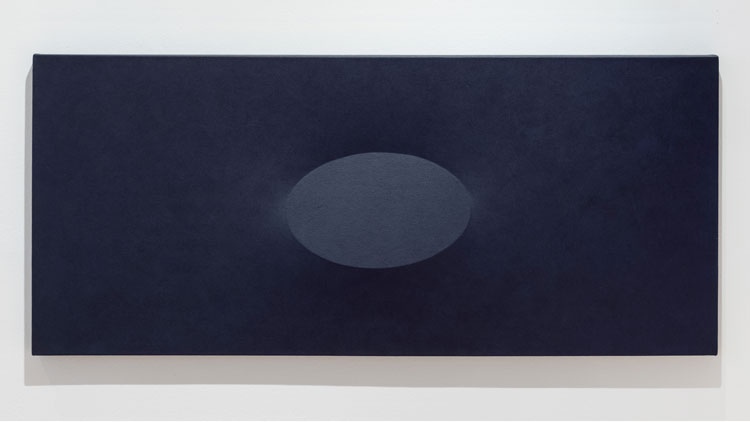
Turi Simeti. Un ovale viola, 1983. Acrylic on shaped canvas, 27 ½ x 63 in (70 × 160 cm). Image courtesy The Mayor Gallery.
Of course, a recurring criticism of monochromatic abstraction is that, despite some of the mystic-metaphysical claims made on its behalf, it offers a sanitised art-lite, painting-as-interior-decoration. Perhaps it is futile to describe any art as being timeless, given that all artworks are made and viewed in a particular time and social space, but away from an art-historical criticism of these works, it is difficult to dispute the immediate magnetism of Simeti’s painting-sculptures, and the allure of seeing a career-long preoccupation with a single leitmotif, without qualms about “reinvention” or novelty. At the same time, there is no reiteration of an easy formula, since the permutations and shifts within these self-imposed limits are there to see even in this microcosm of Simeti’s life’s work. Perhaps counterintuitively, the distillation of plastic and chromatic elements seems to increase rather than reduce what unfolds between the surface of the canvas and the viewer’s vision, something that applies to most well-executed minimalism.
If it seems improbable that, say, arte povera will exert such enduring appeal (Zero scholar Marco Meneguzzo called that movement a “poison” for every other contemporary art tendency), as the 60s start to recede into the mists of history, it is hard to imagine that art objects such as Simeti’s will lose their hypnotic pull.
Slavs and Tatars: The Contest of the Fruits
Rapping fruit, legendary birds and nail art feature in the UK debut of the Berlin-based collective S...
Liverpool Biennial 2025: Bedrock
From Sheila Hicks’s gemstone-like sculptures to Elizabeth Price’s video essay on modernist Catho...
Mikhail Karikis – interview: ‘What is the soundscape of the forthcomin...
Mikhail Karikis explains the ideas behind his new sound and video installation calling for action ag...
Art & the Book* and Spineless Wonders: The Power of Print Unbound**
Two concurrent exhibitions bring special collections into broader spaces of circulation, highlightin...
Focusing on the skills of wallpaper design and embroidery, this exhibition tells the story of the ...
Daphne Wright: Deep-Rooted Things
This show is a celebration of the domestic, and the poignant sculpture of Wright’s two sons, now o...
Anna Boghiguian: The Sunken Boat: A Glimpse into Past Histories
The venerable Egyptian Canadian installation artist Anna Boghiguian brings shipwrecks, shells and th...
Abstract Erotic: Louise Bourgeois, Eva Hesse, Alice Adams
A groundbreaking New York show from 1966 is brought back to life with the work of three women whose ...
Jeremy Deller – interview: ‘I’m not looking for the next thing. I...
How did he go from asking a brass band to play acid house to filming former miners re-enacting a sem...
Encounters: Giacometti x Huma Bhabha
The first of three exhibitions to position historic sculptures by Alberto Giacometti with new works ...
The Parisian scenes that Edward Burra is known for are joyful and sardonic, but his work depicting t...
The 36th Ljubljana Biennale of Graphic Arts: The Oracle
Surprising, thrilling, enchanting – under the artistic direction of Chus Martínez, the works in t...
It’s Terrible the Things I Have to Do to Be Me: On Femininity and Fame ...
In a series of essays about pairs of famous women, the cultural critic Philippa Snow explores the co...
Paul Thek: Seized by Joy. Paintings 1965-1988
A rare London show of elusive queer pioneer Paul Thek captures a quieter side of his unpredictable p...
This elegantly composed exhibition celebrates 25 years’ of awards to female artists by Anonymous W...
The first of its kind, this vast show is a stunning tour of the realism movement of the 1920s and 30...
Maggi Hambling: ‘The sea is sort of inside me now … [and] it’s as if...
Maggi Hambling’s new and highly personal installation, Time, in memory of her longtime partner, To...
Caspar Heinemann takes us on a deep, dark emotional dive with his nihilistic installation that refer...
Complex, multilayered paintings and sculptures reek of the dark histories of slavery and colonialism...
Shown in the context of the historic paintings of Dulwich Picture Gallery, Rachel Jones’s new pain...
William Mackrell – interview: ‘I have an interest in dissecting the my...
William Mackrell's work has included lighting 1,000 candles and getting two horses to pull a car. No...
Marina Tabassum – interview: ‘Architecture is my life and my lifestyle...
The award-winning Bangladeshi architect behind this year’s Serpentine Pavilion on why she has shun...
A cabinet of curiosities – inside the new V&A East Storehouse
Diller Scofidio + Renfro has turned the 2012 Olympics broadcasting centre into a sparkling repositor...
Plásmata 3: We’ve met before, haven’t we?
This nocturnal exhibition organised by the Onassis Foundation’s cultural platform transforms a pub...
Ruth Asawa: Retrospective / Wayne Thiebaud: Art Comes from Art / Walt Disn...
Three well-attended museum exhibitions in San Francisco flag a subtle shift from the current drumbea...
This dazzling exhibition on the centenary of John Singer Sargent’s death celebrates his versatile ...
Through film, sound and dance, Emma Critchley’s continuing investigative project takes audiences o...
Rijksakademie Open Studios: Nora Aurrekoetxea, AYO and Eniwaye Oluwaseyi
At the Rijksakademie’s annual Open Studios event during Amsterdam Art Week, we spoke to three arti...
AYO – interview: Rijksakademie Open Studios
AYO reflects on her upbringing and ancestry in Uganda from her current position as a resident of the...
Eniwaye Oluwaseyi – interview: Rijksakademie Open Studios
Eniwaye Oluwaseyi paints figures, including himself, friends and members of his family, within compo...